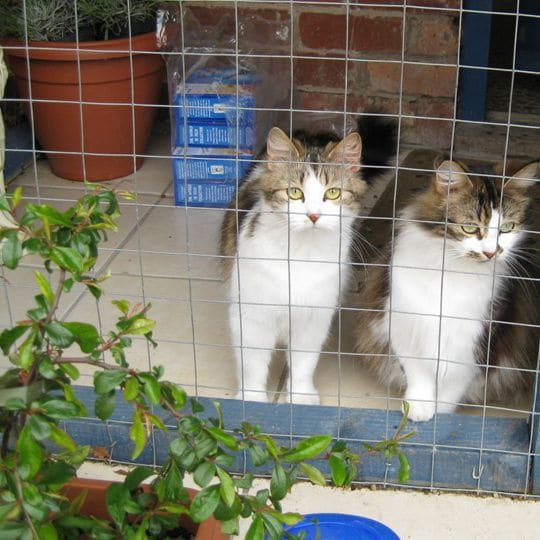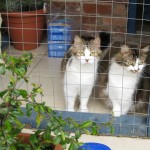Pet Advice Guides for Pet Owners, Sanctuary Life
Keeping more than one cat
If cats are mother and daughter or have been brought up together as kittens, they will normally get on well. These two lovely young-ish ladies are Dimity (on the right) and Delilah (on left) and they are good friends. If you want to introduce a new unknown cat into the household the situation becomes more complicated. Sometimes there is no problem and the two cats hit it off right away. More often though there are spats and hissy fits and one scoots upstairs out of the way. Cats are territorial and need their own core space so they see another feline as an intruder and a threat. Its usual to find that there is a ‘pecking order’ and one cat will be dominant. The two above, Delilah and Dimity, are evenly matched and both are laid back, there is no boss in this relationship. A new cat can be quite vulnerable when trying to cope with the ‘home owner’. This can lead to accidents and mishaps and a temporary change in personality for both cats.
A common complaint is that the new cat isn’t clean. This is always a surprise when we know that the cat in question has been 100% with his or her toileting. The problem is with access to the litter tray or outdoors. It’s unnerving for a cat to go to the toilet when there’s another cat glaring and giving her the ‘dead eye’. Provide two or three litter trays in different locations and give each some privacy – a couple of cardboard boxes make a good screen. It will give the new cat some space and chance to avoid a stressful encounter.
Cat flaps are another potential issue of contention, a subservient cat won’t want to go outside if there’s someone full of fighting talk at the other side of the door. Opening a window will help or you have to fit cat flaps on two different doors. The key to settling a new cat in is to accept that your original cat will take a while to get used to the arrival. Always feed separately and a distance apart and put out two or more water dishes. A multi-cat household has the potential to be a big risk to the well-being and contentment of cats. Making separate sleep areas with a variety of comfort zones works well. Put fleeces, hammocks, cat towers, scratching posts and toys in each area so there is no jealousy.
It’s all about providing escape zones so that if one of your cats feels threatened there is somewhere safe to hide. An outdoor enclosure is a great idea if the budget will run to it. These aren’t difficult to make, the wood can be fairly light but they do have to be meshed in including the roof. A cat patio gives your feline friends access to fresh air and a view of the outside world. When the cats have settled down together, you can open the door and let them go wild-wooding together. Sharing lots of space is the key to cats getting on with each other. If they don’t have enough room to find their own retreat they can suffer chronic stress which may result in disease – idiopathic cystitis is one likely outcome.
Delilah and Dimity are not sisters but they are related. At the moment they are not available for adoption as they have ongoing health problems. With Delilah it’s her ears and poor Dimity has just had to have most of her teeth out, despite eating biscuits every day (Would eating biscuits keep our teeth in good order? I doubt it.). Feeding biscuits to cats is a relatively recent occurrence. Cats used to eat meat and we never used to have cats with mouth problems except in extreme old age. When their teeth fell out that was the end, used to be the same for us humans too! We find that fresh meat, either raw or lightly cooked and cut up into chunks is the best way to keep cats chewing and having good teeth but, sadly, that’s not an option for Dimity any more. She can manage to wuffle a bit of fine mince down but mostly she now dines on pate.


